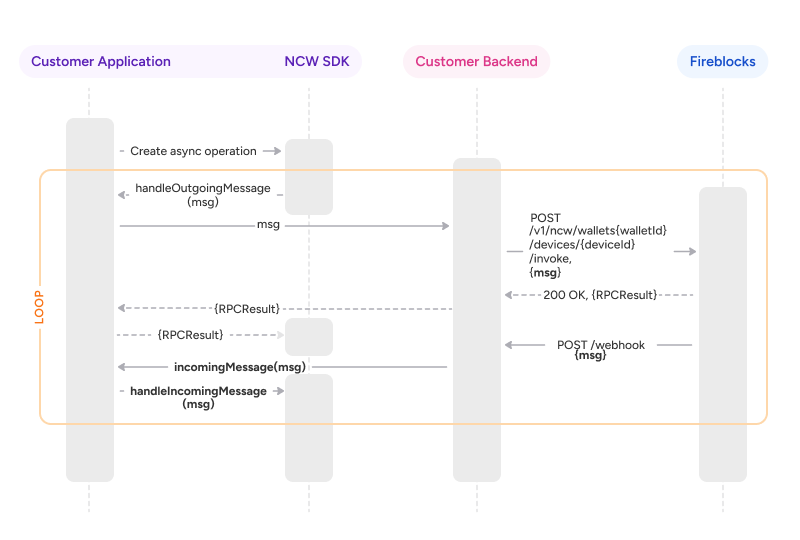Asynchronous Model
Overview
Multi-party computation (MPC) operations, such as new key generation or transaction signing, demand a unique approach. These operations are inherently asynchronous, requiring multiple rounds of communication among various signing participants. This guide aims to explain the nature of MPC's asynchronous model and provide insights into efficiently managing it using webhooks.
Understanding the Asynchronous Nature of MPC Operations
MPC operations require coordination among multiple parties. This collaborative process involves several rounds of communication, contributing to the asynchronous nature of the operations.
Addressing Asynchrony through Fireblocks Webhooks
The Fireblocks NCW feature requires you to set up an endpoint on your backend server. This creates a designated location where the Fireblocks system can push webhook notifications. This webhook carries relevant messages tied to the ongoing MPC operation that needs to be processed on your client side.
Webhook changeBeginning with [email protected], the MPC process no longer requires you to set up webhooks. However, Fireblocks will still use webhooks to send important notifications, such as transaction status changes.
Messages Handling Strategy
Once you've established the webhook endpoint, you can determine how to manage the incoming messages on your client side. Consider the following options:
- Long Polling: In this approach, your client application periodically queries your backend to check if any new messages have arrived.
- Websockets: Websockets provide a real-time communication channel between your client application and your backend. This approach offers instant updates as messages arrive, making it ideal for scenarios that require rapid responses.
- Message Queues: Implementing a message queue system, such as RabbitMQ or Apache Kafka, can help manage and distribute incoming webhook messages efficiently. Your client application can subscribe to the queue and receive messages as they are published.
- Server-Sent Events (SSE): SSE is a technology that allows the server to push real-time updates to the client over a single HTTP connection. This is especially useful when you want to receive updates as they occur without the overhead of managing multiple connections like in WebSockets.
- Firebase Cloud Messaging (FCM): FCM offers real-time mobile and web communication. Through the Firebase Admin SDK, your backend triggers notifications sent to the FCM server. FCM handles delivery to registered clients via unique tokens. The Firebase SDK on the client side manages message reception, delivery, and offline support.
ImportantThe decision regarding the strategy for handling messages lies with the client. Fireblocks does not impose any specific method.
Implementation Steps
- Expose a Webhook Endpoint: Set up a route on your backend server where our system can send webhook messages related to ongoing MPC operations.
- Fireblocks configuration: Configure the webhook URL in your Fireblocks workspace by following this guide.
- Handle Incoming Webhooks: Implement logic on your backend to receive, validate, and process incoming webhook messages. These messages contain crucial information about the progress of MPC operations.
- Client Application Integration: Depending on your chosen strategy, integrate the necessary code into your client application to listen for updates from your backend.
High-level diagram of outgoing and incoming messages

In the diagram above, the following actions take place:
- The client application invokes the NCW SDK MPC handleOutgoingMessage method.
- The SDK generates the required payload, and the application sends it to the customer's backend.
- The backend server invokes the RPC endpoint in the Fireblocks API.
- Fireblocks sends a webhook notification with the corresponding message to be handled by the client's application. This notification is sent to the customer's backend-exposed API endpoint.
- The client application receives the message from the backend using any of the suggested methods and forwards it to the handleIncomingMessage method of the SDK.
- The SDK generates a corresponding message, and the same flow continues until the entire operation is done.
MPC information change & payload content
Beginning with [email protected], you will not be required to handle crucial MPC information. However, there will be other message types you will work with. The following diagram illustrates the new asynchronous model.
The payload's content is produced by the SDK or the Fireblocks platform. Customers don't need to concern themselves with structuring these payloads. They can regard this process as a black box.
Updated about 2 months ago
